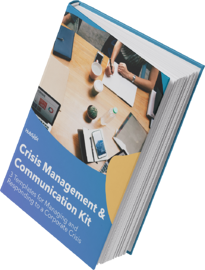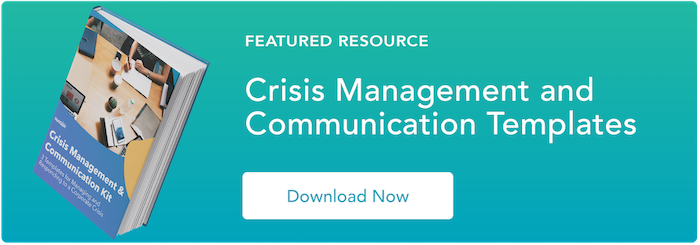There are certain characteristics that should be at the core of any successful business. For instance, every business should have a great product or service, awesome employees to keep the internal engine running, and loyal customers who support through purchases and advocacy.
There also has to be underlying elements to help establish the aforementioned characteristics. And one of the most necessary is clear and effective communication.
Communication is at the root of every interaction for businesses. Without transparent communication at every level, there's more room for error, and — depending on the magnitude of the error — it can make or break a business.
But, while 89% of people feel communication is extremely important for work, 8 out of 10 people rate their own business' communication as either average or poor.
Developing a communication strategy for your business will help you understand how your company best communicates, internally and externally, and can give you measurable results to better understand the efficacy of your communication tactics.
In this post, we'll explain how to create a communication strategy and plan for your business to ensure efficient, cohesive communication with colleagues and customers alike.
What is a communication strategy?
A communication strategy is a process developed by the appropriate stakeholders to identify where communication efforts need to be improved. The next step in this process is to ideate and select measurable actions that will be used to develop a communication plan to achieve your desired outcome.
1. Use a communication plan template.
HubSpot's Communication Plan Templates are a great resource to help you develop actionable steps without having to spend too much of your time on this task.
Your communication plan will clearly go through all of the steps you need to take to address the challenges you're up against — like completing an audit, setting SMART goals, and understanding how long each step in your plan will take. Depending on your overall strategy, you may develop multiple plans to be carried out to meet the needs of different audiences.
You'll want to break your plan into steps so you can easily make and measure progress on a daily, weekly, or monthly basis. Additionally, as you're creating your communications plan, you'll need to factor in a working timeline, potential budget, and ensure you're delegating tasks to the appropriate team members.
Over time, you want to be able to reflect on what changes have been made and if these changes are actively contributing to helping you achieve your ideal results.

Download HubSpot's Crisis Management & Communication Kit today!
2. Determine current and potential problems.
Identifying the problems hindering your company's communication efforts is the first, and most important, step of developing a solid communication strategy.
Start by asking questions like:
- Are we experiencing communication problems internally or externally?
- If externally, is this across all channels of customer communication, or a specific team or department?
- If internally, is this a company-wide issue, or specific team or department?
- Is there a specific issue that arises consistently? If so, what is that issue?
- What are the problems that aren't consistent, but still present challenges?
Ideally, the more questions you ask, the more you'll be able to clearly identify areas for improvement that will influence your overall strategy. If you're struggling to come up with questions, reach out to team members within your company, and/or your customers.
You can issue surveys, start organic conversations in the office or via social media, schedule one-on-ones — whatever you feel will get the most relevant answers.
When there are issues that directly impact company employees or customers, people are more willing to provide feedback. It's also possible that someone may already be working to find a solution to some of the problems you'll identify — which brings us to our next step.
3. Select key stakeholders who need to be involved.
Now that you've asked the right questions, you need to make sure that you involve the right people to help you carry out building your communication strategy.
If you're at a smaller organization, it's possible that you may be the only person you need on your team. However, for larger organizations, you'll most likely want to include a few of your co-workers to help you divide and conquer.
Selecting which individuals should be involved should directly relate to the biggest challenges you identified from your list of questions. If the most pressing challenge is customer-related, you may want to include someone from your organization's customer service or customer success team. If there's an issue about how a product or service is being advertised or sold, include a representative from your marketing or sales team.
You'll also want to make sure that appropriate leadership team members are aware and as involved as they need to be. This way, if you end up wanting to make any major company changes like purchasing a new tool or restructuring teams, leadership will already be aware of what's happening.
If your coworkers are maxed out and don't have the bandwidth to assist you, or the problems are more significant than expected, you may want to source an external agency or a consultant to assist your company. For instance, if you're addressing a major external communications crisis, you may consider contracting a PR agency.
Overall, use your best judgment to select who will be involved and make sure they're involvement ties directly into the specific challenges you've identified.
4. Understand your audience.
Understanding your audience is fairly simple. The audience is either internal (meaning your coworkers, and the company as a whole), external (meaning your customers, shareholders, etc.), or a combination of both.
From there you can get more specific:
- Are you addressing the entire company?
- Are you addressing a certain department or team?
- Are you addressing all customers?
- Are you only addressing certain customers? If so, can you segment by buyer persona or stages of the buyer's journey?
It's important to take the time to thoroughly understand who your audience is so you're truly speaking to them in a way that will be well-received. Once you know who your audience is, you'll be able to use audience insights to inform all stages of development for your communication strategy.
5. Brainstorm your ideal results, and then work backwards.
This is when you use all of the information that you've gathered to propose what your ideal outcome will be. This is a high-level goal that will be achieved through the implementation of a well thought-out plan.
If your business has struggled with communication regarding events, an ideal result could be improving internal alignment and providing clarity for customers.
Alternatively, if you find that employees at your company feel it's difficult to voice their ideas or opinions, your goal might be ensuring all employees feel heard by developing a specific feedback system.
Whatever you specify as your ideal result, keep it simplified so it can be easily understood by anyone. It should carry weight because you're addressing challenges, but it shouldn't be too complex, either. Think of it as the central mission or vision statement of your communication strategy. The details will come after.
Developing an effective strategy is a process and may take a few different tries before you figure out what works best. However, it's a necessary investment to ensure you're clearly communicating the best way possible.
Check out How to Write an Effective Communications Plan [+ Template] and download HubSpot's Free Communication Template to start achieving all of your communication strategy goals.
![How to Create a Communication Strategy [+ Free Templates]](https://localseoresources.com/wp-content/uploads/https://blog.hubspot.com/hs-fs/hubfs/Google%20Drive%20Integration/How%20to%20Create%20a%20Communication%20Strategy%20%5BFree%20Templates%5D.png?width=205&name=How%20to%20Create%20a%20Communication%20Strategy%20%5BFree%20Templates%5D.png)



Recent Comments